
The Clean Ports Program will invest $3 billion in technologies to reduce harmful air and climate pollutants at US ports. The Clean Ports Program builds on EPA’s existing Ports Initiative.
The Clean Heavy-Duty Vehicle Program will invest an additional $1 billion to reduce vehicle emissions and better protect the health of the people living and working near ports, schools, and other truck routes. The Clean Heavy-Duty Vehicle Program provides funding to offset the costs of replacing heavy-duty commercial vehicles with zero-emission vehicles, deploy infrastructure needed to charge, fuel, and maintain these zero-emission vehicles, and develop and train the necessary workforce.
EPA has announced a technical Request for Information(RFI) on zero-emissions heavy-duty vehicles and port equipment to inform the development of these new programs.
EPA is specifically requesting information on the following technologies:
Zero-emission class 6 and 7 heavy-duty vehicles (e.g., electric or fuel cell delivery trucks, refuse trucks, utility trucks, school buses, and day cab tractors).
Zero-emission port equipment (e.g., electric or fuel cell dray trucks, harbor craft, locomotives, and cargo handling equipment).
Associated charging and other fueling infrastructure.
For these different zero-emissions technologies, EPA is requesting information on:
Availability including manufacturer production capacity.
Performance including durability and maintenance requirements.
Pricing including payback period and lifecycle costs relative to those operating on conventional fuels.
Practical considerations for program design including project development best practices and workforce training needs.
Respondents are also requested to explain if equipment and components are currently manufactured in the United States or expect to be in the near future.